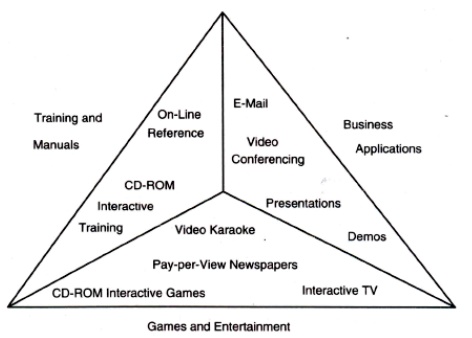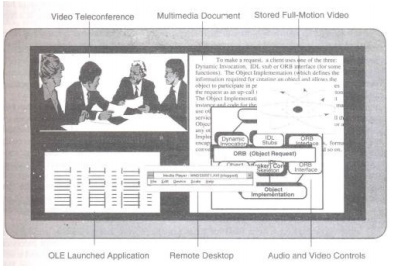Chapter: Graphics and Multimedia : Multimedia Systems Design
Multimedia Applications
MULTIMEDIA APPLICATIONS
The first widely used
application of multimedia is document image management. It is primarily
intended for scanning documents and retaining their images.
Another application is image
processing. It is also known as Image recognition. It is intended for
recognizing objects by analyzing their raster images. Applications that present
a view of generic multimedia applications are:
1. Document Imaging
The fundamental concepts of
storage, compression and decompression, and display technologies used for
multimedia systems were developed for document image management. Organizations
such as insurance agencies law offices,country and state governments, and the
federal government manage large volumes of documents.
Document image technology is
adopted by Department of Defence for applications ranging from military
personnel records to maintenance manuals and high-speed printing systems.
Almost all document image system use workflows that are customized for the
purpose for which they are being used. The workflow defines the sequence for
scanning images, performing data entry
based on the contents of the lmages, indexing them and storing them on optical
media.
Document Image Hardware
requirements:
Realtime image decompression
and display place an important role on image processing hardware. Image
decompression and display hardware supports 4 to 8 planes. 4 planes provide 16
colors and 8 planes provide 256 colors. The image planes are also called bit planes,
because, they are addressed by a bit in a bytes. Images must be processed at
the rate of tens to hundreds of pixels per nano-second. For high-resolution
images, processing of the order of 10 pixels/ ns is enough for monochrome still
images. Gray scale images consist of pixels that have shades of gray ranging
from 16 to 256. Color images feature color hues instead of shades of gray. Most
high-resolution monitors support 16 to 256 colors display capability. The
number of colors that can be depicted depends on the number of bits used to
define the palette.
Image processing and Image
Recognition
Image processing involves
image recognition, Image enhancement,image synthesis, and image reconstruction.
An image processing system
may actually alter the contents of the image itself. Image processing systems
employ the compression and decompression techniques, a wide range of algorithm
for object recognition, comparing images of objects with pre-defined objects,
extrapolating finer details to view edges more clearly, gray-scale balancing
and gray-scale and color adjustments.
Let us briefly review the
various aspects of inlage processing and recognition.
Image enhancement: Most image display systems feature some level of image adjustment.
Increasing the sensitivity
and contrast makes the picture darker by making bonderline pixels black or
increasing the gray-scale level of pixels.
Capabilities built in the
compression boards might include the following
* Image calibration: The overall image
density is calibrated, and the image pixels are adjusted to a predefined level.
* Real time alignment: The image is
aligned in real-time for skewing caused by improper feeding of paper. * Gray-Scale normalization: The overall
gray level of an image or picture is evaluated to determine if it is skewed in
one direction and if it needs cOlTection. * RGB hue intensity adjustment:
Too much color makes picture garish and fuzzy. Automatic hue intensity adjustment brings the hue intensity
within pre-defined ranges. * Color
Separation: A picture with very little color contrast can be dull and may
not bring out the details. The hardware used can detect and adjust the range of
color separation. * Frame averaging:
The intensity level of the frame is averaged to overcome the effects of very
dark or very light areas by adjusting the middle tones.
IMAGE ANIMATION
Computers-created or scanned
images can be displayed sequentially at controlled display speeds to provide
image animation that simulates real processes.
The basic concept of displaying
successive images at short intervals to give the perception of motion is being
used successfully in designing moving parts such as automobile engines.
Image annotation
Image annotation can be
performed in one of two ways: as a text file stored along with the image or as
a small image stored with the original image. The annotation is overlayed over
the original image for display purposes. It requires tracking multiple image
components associated with a single page, decompressing all of them, and ensuring
correct spatial alignment they are overlayed.
Optical Character Recognition
Data entry is the most
expensive component of data processing, because it requires extensive clerical
staff work to enter data.
Automating data entry, both
typed and handwritten, is a significant application that can provide high
returns. Optical Character Recognition (OCR) technology is used for data entry
by scanning typed or printed words in a form.
Initially, people used
dedicated OCR scanners. Now, OCR Technology is available in software. OCR
technology, used as a means of data entry, may be used for capturing entire
paragraphs of text. The capturing text is almost a\ways entered as a field in a
database or in an editable document
Handwriting recognition
Research for Handwriting
recognition was performed for CADI
CAM systems for command recognition. Pen-based systems are designed to allow
the user to write· commands on an electronic tablet. Handwriting recognition
engines use complex algorithms designed to capture data in real time as it is
being input or from an image displayed in a window, depending on the
application. Two factors are important for handwriting recognition. They are
the strokes or shapes being entered, and the velocity of input or the vectoring
that is taking place. The strokes are parsed and processed by a shape
recognizer that tries to determine the geometry and topology of the strokes. It
attempts to compared it to existing shapes, such as predefined characters. The
stroke is compare with the prototype character set until a match is found or
all pre-defined prototypes have been checked without a match.
Multimedia system will use
handwriting recognition as another means of user input.
Non-Textual Image Recognition
Image recognition is a major
technology component in designing, medical and manufacturing fields. Let us
review the basic concepts of image recognition architecture.
For example, a general Image
recognition system,- the Image Understanding Architecture has the design which
calls for three processing layers.
(i) 512 x 512 array of custom
pixel processors that extract basic features such as lines and object
boundaries. (ii) The features of an object extracted by the first layer are
tracked by the DSP array, and that information is fed into 5l2-M byte RAM.
(iii) At the highest level, sophisticated AI algorithms perform the difficult
task of object and scene recognition. .
Full motion Digital video
Applications
Full motion video has
applications in the games industry and training, as well as the business world.
Full motion video is the most complex and most demanding component of
multimedia applications.
For business applications,
some core requirements are needed.
(i)
Full-motion video clips should be sharable but should have only one
sharable copy.
(ii)
It should be possible to attach full-motion video clips to other
documents such as memos, chapter text, presentation, and so on.

The following features should
be available:
(a) Features, of a VCR
metaphor, such as, rewind, fast-forward, play, and search.(b) Ability to move
and resize the window displaying the video clip. (c) Ability to view the same
clip on a variety of display terminal types with varying resolution
capabilities without the need for storing multiple copies in different form (d)
Ability to adjust the contrast and brightness of the video clip. (e) Ability to
adjust the volume of the associated sound. (I) It should enable the users to
place their own indexing marks to locate segments in video clip.
A Universal Multimedia Application
It is an application that
works on universal data type. This means that the application manipulates
datatypes that can be combined in a document, displayed 'on a screen, or
printed, with no special manipulations that the user needs to perform. The
application is truly distributed in nature.
An important consideration
for such a universal application is the methodology for dissemination of the
information on a network.

Figure describes the user screen for a universal multimedia application. In
this screen, mix of windows for displaying still video and document images, a
video conference window with a live session in progress, a remote live desk
top, and a couple of other windows for applications such as electronic mail and
desk top publishing.
To maintain all of these
windows requires a substantial amount of CPU power. Digital Signal Processing
assistance is needed to manage the multiple simultaneous decompressions for
JPEG, MPEG and windows applications.
3. Full-Motion Video Messages
In addition to textual
messages, electronic mail capability allows embedding of voice messages and
video messages. Video messages may consist of video snapshots or live video
with full-motion picture and sound.
Two technological concepts at
play in the implementation of full motion video messages:
(i)
The storage and transmitted of a very large volume of data at a
high rate,
(ii)
Decompression of that data to present a continuous play back
Audio and Video Indexing.
Indexing is an important and
complex subject for multimedia design. Marking a position is called Indexing.
Audio and video indexing are used in full-motion video in a manner similar to
any video sequence, i.e.,. just as it would in a home movie, taped performance
and so on.
The needs of the application
must be a strong consideration for the type of indexing provideq with the
system.
Key points for indexing of
stored video clips:
*
Indexing is useful only if the video is stored, indexing
information is lost.
*
When sound and video are decompressed and managed separately,
synchronization is very important.
*
Depending on the application, indexing information must be
maintained separately for sound and video components of a video clip.
Related Topics